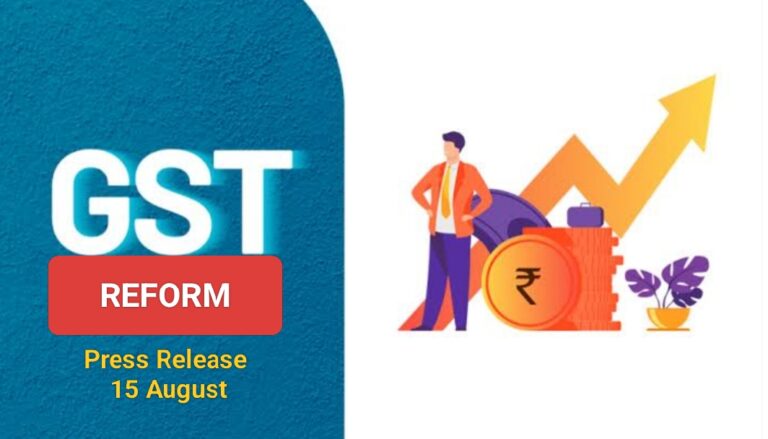On 15 August 2025, during his Independence Day address, Prime Minister Narendra Modi announced a landmark reform of India’s Goods and Services Tax (GST) regime, positioning it as the “Next-Generation GST.” The reform aims to simplify India’s indirect tax system through structural corrections, rate rationalisation, and technology-driven compliance, making GST more citizen-friendly and business-oriented. A key highlight is the proposed shift to a two-slab structure (5% and 18%), replacing multiple existing rates, with special higher rates reserved only for a limited set of demerit goods. This reform is projected to boost consumption, reduce inflationary pressures, and enhance ease of doing business, while ensuring long-term stability and predictability in the GST framework.
Official Announcement — 15 August 2025 (Independence Day)
Source: Press Information Bureau (PIB) Release (10:51 AM, 15 August 2025)
Prime Minister Narendra Modi outlined a transformative “Next-Generation GST” reform, guided by three core pillars:
- Structural reforms
- Correct inverted duty structures: Align input and output tax rates to reduce input tax credit accumulation.
- Resolve classification issues: Streamline categorizations to minimize disputes and simplify compliance.
- Ensure long-term stability: Provide predictability in rates and policy for better business planning.
- Rate rationalisation
- Reduce GST on essential and aspirational goods to improve affordability and boost consumption.
- Move towards a two-slab system: “Standard” and “Merit” rates, with special rates only for a select few items.
- Fiscal flexibility: The phase-out of compensation cess has created space for rate rationalisation.
- Ease of living
- Simplified and tech-driven registration for small businesses and startups.
- Pre-filled returns to reduce mismatches and manual interventions.
- Faster, automated refunds, particularly for exporters and sectors affected by inverted duty structures.
The proposal has been forwarded to the Group of Ministers (GoM) under the GST Council for further review and state-level consultations.
Media Reporting Highlights and Supplementary Details
Economic Times & Times of India (15 August)
- Simplified two-slab GST system proposed, with special rates only for select goods. Emphasis on benefiting middle class, students, women, farmers, and small industries.
Reuters (15 August)
- Plan to replace the 12% and 28% slabs with a two-rate system of 5% and 18%. About 99% of items currently taxed at 12%—such as butter, fruit juices, and dry fruits—would move to 5%, effective by Diwali. Estimated revenue loss: ₹500 billion (about 0.15% of GDP), but could serve as a fiscal stimulus of 0.6–0.7% of GDP.
Reuters follow-up (18 August)
- Additional proposals include:
- GST on small petrol and diesel cars reduced from 28% to 18%.
- Insurance premiums (health/life) may see GST lowered to 5% or potentially zero.
Financial and Economic Impact Analysis
- Livemint / Expert views: GST reforms are viewed as potentially game-changing—boosting disposable incomes, driving consumption, and giving the Reserve Bank of India room to consider rate cuts.
- SBI Research: Projects consumption boost of ₹1.98 lakh crore, with an annual revenue loss of ₹85,000 crore. Average effective GST rates could drop from ~11.6% to ~9.5%, inflation easing by 20–25 bp, especially for food, with reforms likely in effect from October. Combined fiscal impact including income tax cuts could translate to ~1.6% of GDP.
- S&P Global: While acknowledging possible short-term revenue loss, S&P anticipates easier implementation and greater compliance may bolster long-term revenue. India’s recent sovereign rating upgrade reflects confidence in this path.
Summary Table
| Aspect | Key Detail |
|---|---|
| Announced Date | 15 August 2025 (Independence Day) |
| Core Pillars | Structural reforms, Rate rationalisation, Ease of living |
| Proposed GST Slabs | Two main rates: 5% (merit/essential items) and 18% (standard) |
| Special Rates | Higher rates (e.g., 40%) for a very small set of sin/demerit goods |
| Target Date | By Diwali 2025 (October) |
| Notable Reductions | 12% → 5% for most categories; Cars: 28% → 18%; Insurance: potentially 5% or 0% |
| Economic Effects | Boosts consumption, affordability; possible inflation easing; temporary revenue loss |
| Consultation Process | Proposal sent to GoM and GST Council; state-level approvals being sought |
| Implementation Tools | Simplified registration, pre-filled returns, faster refunds |
